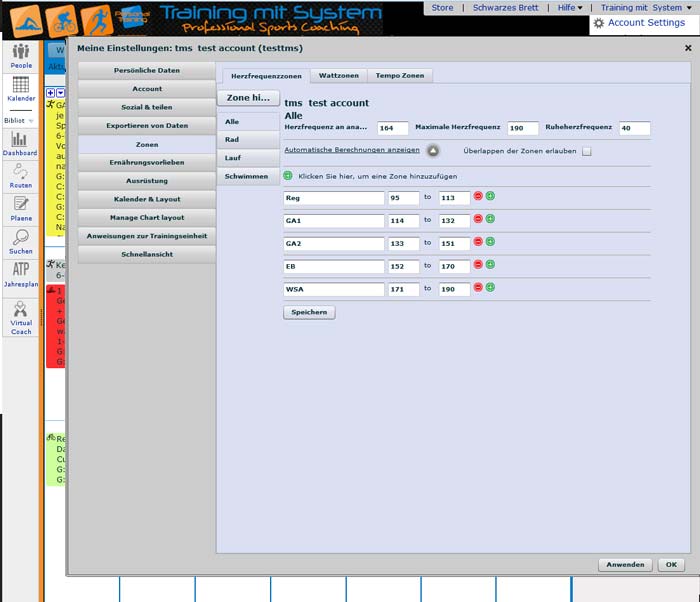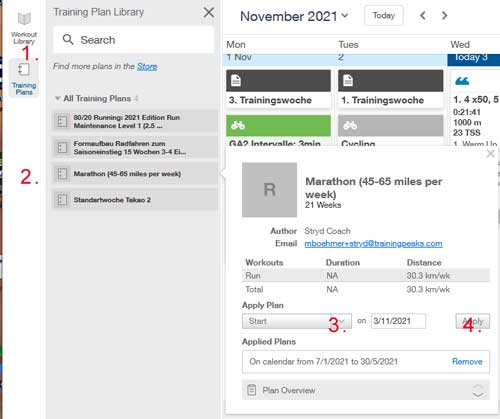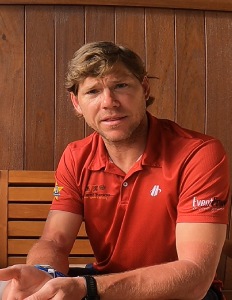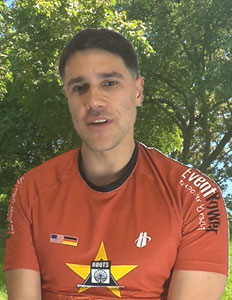3. FAQ - Questions about our training process
- 1. What Training Zones do exist, and what are they good for?
-
2. Where can I find my training zones?
You can find the training zones by clicking on the name in the upper right corner of the account, here a menu "Account Settings" opens

In the opening window under Zones you will find the training zones and their assigned heart rates or power zones (watts & speed zones).
Please note that it is possible to assign different heart rates to the training zones for different sports.

Athletes without a coaching option must adjust these training areas themselves. Instructions can be found here in the corresponding section under the different sports.
-
3. What training methods are existent and what are they used for?
SE - Steady Effort
Training method primarily to improve basic endurance, aerobic capacity and long-term endurance. The continuous method is characterized by the fact that the endurance load is steady and without pause. The endurance method improves endurance performance.
FS - Fartlek
In the driving game, the adaptation of the speed takes place through situation-adapted (subjective condition, terrain) speed change of the athlete. The distances and the load intensity can be freely selected according to the requirements.
IM - Interval Method (tempo alternation)
Training method to improve endurance, which is characterized by systematic alternation of stress and relief. The interval method is characterized by the fact that the load is interrupted by load pauses.
WM - Repetition Method
With the repetition method, a distance is repeated several times, an almost complete recovery usually takes place in between the repetitions. Usually an under distance is denied, in order to be able to cover all repetitions with competition speed or faster.
-
4. What is the structure of a training session?
The basic setup of a training Session:
1. Warm up (running, running, swimming)
2. Main set
3. Cool down (running, running, swimming)
All heart rates, power, or speed values are output individually *
* Prerequisite is that the test values achieved in the Test sessions are transferred accordingly.
Bike or Run Session setupWarm up
- 5:00 min @ 129 - 135 1/minRepeat 10 x
- 5:00 min Z2 easy @ 137 - 146 1/min - Z2
- 5:00 min Z3 middle @ 149 - 161 1/min - Z3Repeat 5 x
- 4:30 min Z2 easy @ 137 - 146 1/min - Z2
- 0:30 min technique drills @ 137 - 161 1/min - Z3Cool Down
- 5:00 min @ 129 - 135 1/min
Swim Session setupWarm up
- 300 m @ 01:49-01:53 sec/100m .Repeat 6 x
- 50 m (25m technique - 25m loose) @ 01:41-01:49 sec/100m - loose - Z2
- Rest 30 sec @ 00:00 sec/100mRepeat 2 x
- 200 m @ 01:37-01:43 sec/100m - medium - Z3
- Rest 30 sec @ 00:00 sec/100m400m - maximum speed
- 400 m @ 01:30-01:31 sec/100m fast - Z5Repeat 10 x
- 50 m Medium (alternating with and without Pb (Pull Bouy)) @ 01:23-01:30 sec/100m very fast - Z6
- rest 45 sec @ 00:00 sec/100mCool Down
- 200 m @ 01:49-01:49 sec/100m - Z1 -
5. What about stretching and stabilization training?
Stretching should be part of every training day routine.
There are many forms of stretching, you should find the right one for you and incorporate it into your daily routine.Stabilization training should also be part of the general training program.
Stretching or Stabilization/strength training is entered in the category "Strength/strength training" in the training protocol.
-
6. What are test sessions and what is the purpose of it?
These special sessions are planned several times during the season/training plan and serve as a reference for performance comparison and adjustment of your training zones.
Further information can be found at later here.
-
7. Which technique drills do we recommmend for swimming?
Which technique drills do we recommend for swimming?
-
8.Which technical drills do we recommend for cycling?
All exercises and videos can be found here (technique drills biking).
-
9. Which technical drills do we recommend for running?
All exercises and videos can be found here (technique drills running).
-
10. Individual adjustment options for the length of the training sessions
Because not everything always goes 100% according to plan—whether in training or life—here are a few tips for adapting your training plan.
The sessions in the training plan are structured and systematically build on each other. If the plan ever feels too easy, too short, or too hard—or if perfect weather calls for a longer bike ride—you can make the following adjustments.
For athletes with the coaching option, the coach writes the plan, and minor adjustments should only be made on the day due to weather changes or last-minute scheduling issues.
Individual Adjustment Options for Session Length
Running and Cycling
Long, low-intensity sessions with mostly Zone 2 training:
-
Extend the session by adding additional time at Zone 2 pace to the end of the session, and/or increase the number of intervals accordingly.
-
Never extend a session by more than 30%.
More intense sessions (Zone 2/Strength/Threshold/Sprint work ):
-
Do not extend sessions by increasing the rest time between intervals—this changes the nature of the workout and can be counterproductive.
Option 1:
-
Ensure the total duration of intense intervals is never more than 20% longer than the distance or time of your goal race segment.
-
For example, Olympic-distance bike leg = 90 minutes → max allowable intense interval time = 108 minutes (90 min + 18 min).
Example:
Original session:
-
Repeat 10x (5 min GA1 – 5 min KA)
→ Total Interval time: 10 x 5 min = 50 min
→ Max extension (20% of 50 min) = 10 min
→ You may add up to 2 more intervals of 5 min each.Option 2:
-
Standalone or brick session: After completing intervals, extend by continuing at Zone 2 pace using the continuous method.
-
Brick sessions: Extend before intervals with Zone 2 continuous method, to avoid altering the intensity profile before the transition.
Swimming
Depending on the training goal, you can modify the main set:
-
Prefer to shorten by reducing the length of intervals.
-
Prefer to extend by increasing the number of repetitions.
Example Session:
-
Warm-up
300m/y @ 1:49–1:53 per 100m/y -
Repeat 2x technique drills:
50m/y @ 1:41–1:53/100m/y – easy – GA1
30 sec rest -
Repeat 2x extension set (250m/y or 300m/y):
200m/y @ 1:37–1:43/100m – moderate – GA2
30 sec rest -
Main set:
400m/y max speed
Extension: 500m/y
Reduction: 300m/y or 200m/y
Pace: 1:30–1:31/100m – fast -
Repeat 10x (extension: 12–20x 50m/y / reduction: 10x 25m/y):
50m/y moderate with/without pull buoy alternated
Pace: 1:23–1:30/100m/y – very fast – WSA Sprint
45 sec rest -
Cool-down:
200m/y @ 1:49–1:53/100m/y – recovery
In the early weeks, training is kept intentionally light, and some swim sessions may include instructions for extending the session. Follow them if included.
Open Water Swimming
In the final training weeks, sessions will explicitly include open water swims.
-
If open water sessions aren't possible, complete them in a pool instead.
-
If wetsuits are not allowed in your race, swim in race gear (e.g., trisuit).
Option 1 – Training in the pool instead of open water:
-
Swim fully or partially with a wetsuit.
-
In outdoor pools, the wetsuit can be worn only at the beginning—monitor body temperature and remove early if necessary.
-
To simulate the wetsuit, use a pull buoy (unless your race is non-wetsuit).
Option 2 – Training in open water instead of a pool:
-
Use this option whenever possible.
-
Include the planned workout in the open water session.
-
Adapt rest times to actual swim breaks or easy swimming.
-
Include buildups and intervals during continuous, steady-paced swims.
Swapping Training Sessions Between Days
Swapping sessions between days is totally normal and possible.
-
With lower weekly training volume, this is even easier to manage.
-
Swim sessions are generally easy to swap. This is helpful if pool hours or open water access favor another schedule.
-
You can place swim sessions on recovery days. However, ensure at least one recovery day per week is completely free or includes only strength/stability work.
Important when swapping sessions:
-
Avoid doing multiple intense sessions on the same day.
-
Avoid frequent stacking of high-intensity sessions.
-
Make sure there is sufficient recovery time between intense sessions.
-
Brick sessions (combined workouts) should remain intact if possible.
-
Weekend sessions should be swapped as a block, by day.
Missed sessions can be made up within 3 days, as long as:
-
They don't eliminate a rest day.
-
They don't replace another session in the same discipline.
-
-
11. How does the training plan or TrainingPeaks recognize an improvement in performance and how can I train with the resulting training zones and load?
TrainingPeaks does not detect any improvement in performance or does not automatically adjust training zones.
TrainingPeaks provides the data to detect a change in the performance. We as trainers can interpret this data with our experience and can change the training areas in consultation with the athlete.
As an athlete with a training plan, you have the possibility to do the tests that are usually repeated every 12 weeks and then, with the help of our instructions, convert the test results into a threshold value.
After you have entered this value in the TrainingPeaks settings of the corresponding sport, they are then converted into new training zones and used automatically in the following training sessions. -
12. How can I set a realistic target time for my race?
Indeed, this is a difficult question and cannot be answered satisfactorily in all cases. In any case, we need your test results, e.g. from the tests that we include in the training plans and that are repeated after about 12 weeks, and significant training results that are comparable for the competition. These, we can see if the "athlete account" is shared with our "coach account". Send us a request and we will help you to predict or orientate for a target time.
-
13. How do I recognize the periodization in my training plan?
In every training plan provided via TrainingPeaks, an individual instruction for the specific training plan is available to download on Monday of the second week. In this PDF both the weekly training hours are shown in table form and the corresponding training priorities of the corresponding current training block. In addition, many other details of the training plan are provided and explanations are given.
-
14. How can I reuse a training plan?
1. In your Training Peak account on the left side, go to training plans (Training Plan)
2. Open the corresponding plan
3. Choose the new start or end date and confirm with "Apply".
4. Confirm with "Apply
After that, the plan is reassigned again.
If this does not work, please contact us.

-
15. Should I adjust the training sessions for the indoor trainer?
Riding on an indoor trainer is usually a bit harder than outdoors. Both heart rate and wattage values can vary, so you might want to test separately for a different threshold. We've had athletes whose values differ by more than 10%.
I always recommend keeping the conditions as similar as possible, using the same bike and ensuring as much ventilation as possible. For different bikes, the seating position and crank length should be as similar as possible. Then there's the stress factor. You could say it's harder on the indoor trainer, as you have fewer rest periods for rolling or standing, and you're not moving dynamically. Good riders also try to minimize the rolling times outdoors. I'm thinking of downhill rolling or something similar, where you also pedal downhill.
I wouldn't shorten the session; I would consider it "additional training."
Your benefits with us:

Fast delivery
Usually within 24 hours.

Very Good
Quality has priority

Sustainable
All plans can be reused as often as required.

Exchange service
Plan exchange or return within the first 21 days.

Hight Quality Service
Direct availability or callback in case of questions
Talk to us  Phone: +49 - 3834 - 3189895 or Contact Support
Phone: +49 - 3834 - 3189895 or Contact Support
Our Team:

Takao Mühmel

Pete Ventura

Marcel Mithöfer

Marc Wolf

Marcus Schmidt
 EN
EN  DE
DE 






